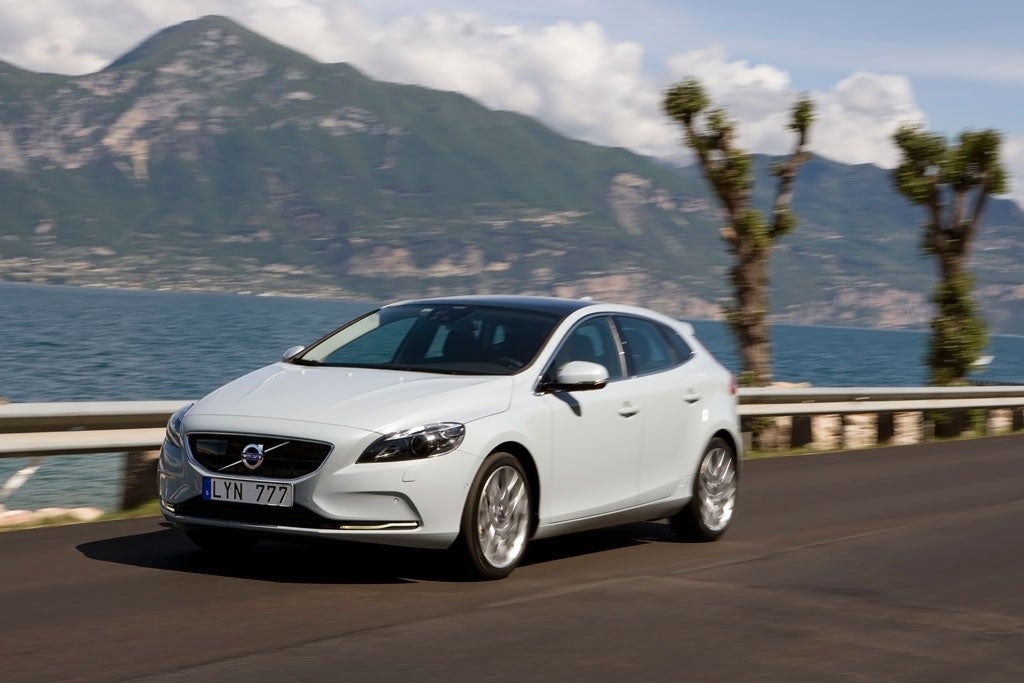
Price: £19,745
Engine: 1,560cc, four cylinders, 16 valves, turbodiesel, 115bhp
Transmission: Six-speed gearbox, front-wheel drive
Performance:118mph, 0-62 in 11.7sec, 78.5mpg, CO2 94g/km
What is a Volvo? Solid, square, safe. That was the stereotype at one time, although in the 1980s and 1990s there were some wonderfully subversive variations on this theme with mad turbocharged engines and remarkable pace. Then Volvo went all Scandi style, playing down the safe and sensible because by then it was a given – but its new "sporty" veneer was not borne out by the driving experience. Now Volvo is owned by the ambitious Chinese car-maker Geely, but the Swedish company still buys in some components and expertise from former owner Ford. The first product from the new era is the V40 you see here, the company's first five-door hatchback since the 440 of 1988.
The V40 is quite curvy. But they are mainly tight, spare curves, and the effect is both modern and convincingly Volvoid. The thick "shoulders" contain a scooped-out section below the rear side windows meant to evoke a similar motif on the old P1800 coupé, Roger Moore's chosen transport as Simon Templar in The Saint, while beyond the tapering window outline is a striking, zig-zagging tail-light. These rear lights book-end a deep rear window redolent of that found in the 1800 ES, the sporting- estate version of Templar's car.
Inside, the look is typically Volvo, with simple, clean shapes and an almost Audi level of tactile satisfaction. So far, then, the maker's identity is very clear. Under the skin, though, the V40 is a close relative of the Ford Focus just as the outgoing C30 (coupé), S40 (saloon) and V50 (estate car) all were. The V40 is deemed both racy enough and practical enough to replace all three.
Close Focus relative it might be, but how the V40 feels to drive is the work of Volvo's own engineers. More robust front suspension struts and detailed recalibration of the electric power-steering give a crisper, more transparent and more natural steering feel, and the V40 also rides a little more fluently than the Focus, and the way the car interacts with its driver makes it a great companion on a twisty mountain road.
That's if powered by one of the four-cylinder engines, at least. The most parsimonious of these is the D2 turbodiesel with 1.6 litres, 115bhp, as little as 94g/km CO2 and a smooth, willing if not ultimately very energetic gait, matched to a precise and easy six-speed gear change. Otherwise there are two 1.6-litre, turbocharged petrol engines with 150 or 180bhp, named T3 and T4; I drove the latter, with its optional double-clutch automatic, and it proved enjoyably vigorous.
Volvo has stayed with its characteristic five-cylinder engines for the more powerful diesel V40s, two 2.0 litre units with 150bhp or 177bhp and D3 or D4 tags. The automatic D4 I drove was not great, partly because the heavier engine takes away some of the delicacy but, worse, the automatic gearbox option is matched badly to the engine. The initial accelerator response is too violent, making the transmission surge and smooth driving almost impossible.
Safety kit includes the world's first pedestrian airbag, which raises the back of the bonnet and cushions the base of the windscreen, and an improvement to the City Safety system, which can automatically stop the V40 from up to 31mph if it detects an obstruction ahead.
Before I drove the new Volvo V40 I thought it would be competent but forgettable. I was wrong; it's much better than that, and the way it handles bends and bumps might just be best in class.
Subscribe to Independent Premium to bookmark this article
Want to bookmark your favourite articles and stories to read or reference later? Start your Independent Premium subscription today.

Join our commenting forum
Join thought-provoking conversations, follow other Independent readers and see their replies